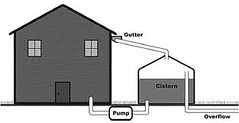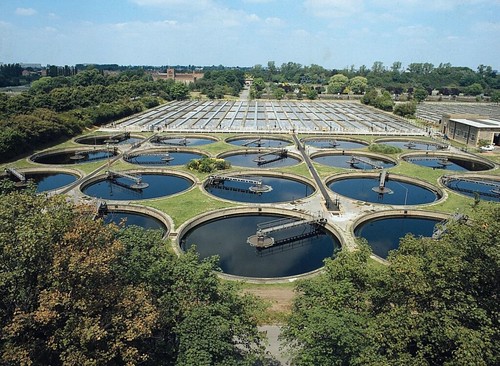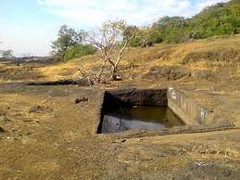There are many things you can do to make your garden more sustainable and the responsible use of water is one of the most important elements. We gathered examples of the thoughtful use of water in traditional gardens and those with a strong focus on permaculture principles.
Wells
Wells are widely and traditionally used for garden watering as they help people save money. They can be found in yards or larger fields.
Cane, wicker, clover, moss and rushes, bramble, poplars are plants indicating that water is in the ground. If those plants are dry in summer, then the water is near the soil surface and not abundant. If those plants are dense and green, then the water is deep and abundant. Another indication of ground water is muddy soil.
To be sure there's ground water, we dig a hole 1 ½ metres deep, we spread some oil on the inner part of a metal container and place it upside down in the hole. We cover it with soil. Next morning, before sunrise, we dig out the container and if there's moisture on its wall, then there's ground water, if there are drops on its walls then there's water in big quantity. Instead of the metal container we can put a dry sponge in the hole which we cover with grass and sticks. If next morning the sponge is wet, then there's ground water and we can make a well there.
How to maintain a well
To prevent iron-reducing bacteria and/or mineral incrustation from accumulating, we should:
- Keep continuous records of well operation by measuring and recording its performance.
- Never allow the pumping level to drop below the top of the screen as exposure to air (oxygen) will accelerate the buildup of mineral deposits and incrustation.
- Annually chlorinate the well, preferably in autumn because many bacteria grow best in still water during the winter.
Finally, we have an electric pump installed but cheaper and more sustainable will be a solar driven pump.
Cisterns
 We know it from the Romans, but also nowadays, cisterns are widely used to gather rain water to be used for household needs and gardens.
We know it from the Romans, but also nowadays, cisterns are widely used to gather rain water to be used for household needs and gardens.
Rain water is considered the best for vegetable watering as it doesn't contain any salts.
Rain water collection
There are also regions in Europe where it rains a lot and therefore the area has plenty of water, also from rivers and springs.
The need to irrigate gardens and fields is limited to short periods in summer, sometimes there is, rather, the opposite problem ;-)
For the driest periods, or in areas the more distant from waterways we try to collect rainwater and create a reserve, building tanks, ponds or tanks of other types.
Water management in a Welsh forest garden
Water management in this area is primarily concerned with flood defense. Our community garden has no natural rainwater collection at this time, though this is planned for the near future when we have structures with water run-off to collect in water butts.
When the land was donated to us it was heavily wooded with mixed deciduous. Our first task was to fell enough trees to raise light levels and let direct sunlight into the garden. Many trees were retained as they act as consumers of water absorbing ground water and preventing loss of soil through erosion. The trees also bring up nutrients form the deep soil returning it to the surface through leaf fall.
The trees, therefore, form part of the water and soil management of the garden.
The main idea behind the forest garden is utilization of three dimensional space. A the lowest level we plant vegetables and herbs, at a higher level tomatoes and beans, higher again soft fruit, then fruit trees and finally nuts (hazel and sweet chestnut). In this way we can increase the production per square meter and encourage companionship planting where one plant assist the development of another.
Ditches
Using the channeled water from rivers and springs is also a common way to irrigate your garden. Ditches are channels that carry water from a spring or a river towards the towns, were originally used primarily to derive the motive power for mills and workshops. Usually the water is returned to the river downstream.
Drip irrigation systems
No matter which water source one uses, automatic watering is applied because we:
- save time, work and cost (15-20% or more in water savings).
- water according to the plants needs
- get healthier plants and crops
A drip irrigation system is the most efficient and usual method because it delivers precise amounts of water slowly and evenly at the plant's roots, eliminating water waste. The slow, consistent application of water at or near the plants' roots reduces weeds and plant disease as we avoid wetting the plants' leaves which usually get infected by diseases when they get wet.
The system is adjusted according to temperature, season, plant changes and checked regularly. In places/times with high temperatures we water at early morning as water lost to evaporation is less in the early hours or very late in the evening.
We make shallow ditches in our garden which will help maximum water absorption.
You can build small and simple irrigation systems by your own by using recycled materials.
Check out this video where people built an irrigation system from an old hose and tubes pen "BIC".
Drip irrigation in dry areas

 At the mediterranean, you have areas with very dry summers, argilous soil and often slightly hilly landscapes.
At the mediterranean, you have areas with very dry summers, argilous soil and often slightly hilly landscapes.
Water is limited and often forbidden to use tap water for plant irrigation.
Therefore, we need to imagine a technique for an economic use of water to maintain a good soil moisture.
Here is the procedure:
- Terrace the ground and bound it with wooden planks to prevent water and
 soil runoff
soil runoff - Dig ditches, 40 cm wide and 20 cm deep.

- Install a tube, approx. 10 cm in diameter, then perforate it every 30 cm and let it come out at the ends in order to insert a garden hose.

-
Sprinkle on the bottom of the bed a layer of dung or compost and cover all with straw.
-
Plant vegetables at the bottom and companion plants (e.g. dwarf beans,tagetes or other small flowers)
Processed waste water
Watering with processed waste water is a system applied in some regions, especially for extended pieces of land and cultivations. The water undergoes a special process, it is decontaminated with Ultra Violet radiation (UV), then, through pumping and pipes, it is channeled to tanks and from there it passes into irrigation networks.
Productive Ecological Sewage Water Treatment Systems
 Beware of contaminated water which is killing more than 8 million people each year because of water related diseases like Diarrhoe, Cholera, Typhus etc.
Beware of contaminated water which is killing more than 8 million people each year because of water related diseases like Diarrhoe, Cholera, Typhus etc.
We distinguish between blackwater which is contaminated by human faeces and greywater which is the waste water from showers, kitchens, sinks, etc.
So first of all: try not to create blackwater. Better use compost toilets, and reuse greywater!
Second, deal safely with  waste water and in an ecological manner. Try to integrate the reuse of water into your daily life.
waste water and in an ecological manner. Try to integrate the reuse of water into your daily life.
In contrast to conventional systems, which are intensive in engineering and costly for the construction, maintenance and repairs, better get inspired by ecosystems for alternatives which are cheap and self-maintaining.
One such alternative is the:
Wetland Ecological Treatment System
- uses living organisms like plants, fungis, bacteria, microbes
for cleaning the water, - needs no concrete or tanks, but uses gravity and solar energy
- never breaks down, but adapts and evolves, thus even gets better with age
- embodies high biodiversity with many wildlife habitats
- little cost after initial investment
Another alternative system is the Fossa Bioseptica- Evaporation Bassin: a Brazilian design for transforming a septic tank system into a productive biological treatment system.
Turning waste into resources
Wetland Ecological Treatment Systems help to turn the sewage water into plant biomass, so create many valuable ressources:
- Building material: Timber, bamboo, for thatched roofs
- Food: Fruits, nuts, animal fodder, vegetables, fish
- Fuel: Firewood, ethanol crops, biogas
Conclusion
With a reasonable handling of sewage water we can solve many problems at once - improve the hygienic situation and sanitation (e.g. in slums), avoid eutrophication, avoid fish kill, save energy, save money, grow ressources, gain independence...





Recent comments